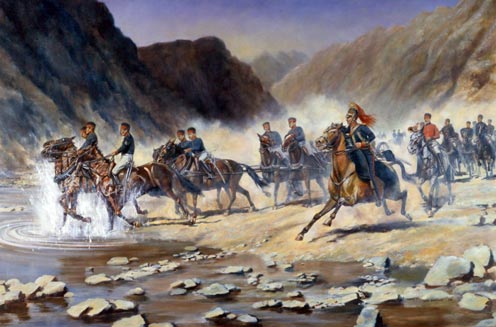
"Shah Sujah's Horse Artillery, during the 1st Afghan War "
Ref: DR020
by David Rowlands
Giclee Print 58 x 38 cm
1838-42: 1st and 2nd Troops, Shah Sujah's Horse Artillery were raised in 1839 at Meerut and Delhi by Captain William Anderson. They were to be the artillery of a force of volunteers which would act as the bodyguard of Shah Sujah, the deposed king of Afghanistan, whom the Government of India sought to replace on his former throne. They were armed with the standard issue of five 6-pounder guns and one 12-pounder howitzer, with the men of the gun detachments riding on all six of the horses of the gun and wagon teams.
By the winter of 1839 they had arrived in Kandahar and formed the artillery of General Nott, who was in command in Southern Afghanistan. During the following two years there followed a whole series of actions in which the Horse Artillery and the infantry deployed to fight in line. As the fanatical ghazis charged towards them, they would wait with steady nerves and perfect gun drill until the Afghans came to within very close range. With accurate timing, two salvoes of case shot could break up an attack before it came to close quarters.
Captain Cooper made an accurate drawing of his Troop on campaign. The gunners are seen wearing white leather breeches and long jack boots. The NCO and men wear a form of low turban, and a stable jacket with a single row of buttons down the front. Swords are suspended by slings from the waistbelt. I have depicted the officer wearing his helmet with a leopard-skin turban, and the red horse-hair mane so distinctive of the Bengal Horse Artillery. We know from other sources that it was worn on campaign and not restricted to the parade ground. He wears the Undress shell jacket, and under his saddle is the Undress shabraque. Trumpeters, who were often Eurasians, wore jackets of reversed colours (in this case, red), and were mounted on grey or piebald horses.
When the 1st Afghan War came to an end, the two Troops were amalgamated into one, and took their place as the 5th (Native) Troop of the 1st Brigade, Bengal Horse Artillery. In 1861 it was absorbed into the Royal Artillery, where its traditions are still preserved and honoured.
